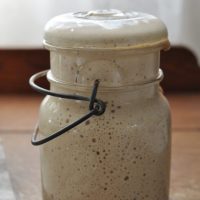How to Make Sourdough Starter From Scratch
Learn how to make a simple homemade sourdough starter from scratch!
Ingredients
- 3/4 cup whole wheat flour
- 1/2 cup water
Instructions
- Step One: Add 3/4 cup flour (I use whole wheat) and 1/2 cup filtered water to a quart jar. Mix thoroughly (using a whipping motion to incorporate air) and scrape down the sides of the jar. Cover loosely with a piece of plastic wrap, small cloth, paper napkin, or coffee filter. Secure with a rubber band or a canning ring. Let sit for 12 hours at room temperature (between 65 and 85 degrees F is the best). If your kitchen is cold, you can put the jar in the oven with the oven light on.
- Step Two: After 12 hours, check the starter. If there are bubbles*, add 1/2 cup water to the jar. Stir well. Add 3/4 cup flour. Stir well and scrape down the sides of the jar. Cover, and set aside for 12 hours. *If you don't see any bubbles, stir, scrape sides of the jar, replace cover, and allow to sit for about 12 more hours. Then check again. If there are bubbles this time, add 1/2 cup water and stir. Add 3/4 cup flour and stir, scrape down sides, and cover.
- Step Three: After 12 more hours, check your starter. By this point, you might see lots of bubbles and it may have doubled in size. If you see bubbles*, stir well, and discard half of the starter. Get a clean quart jar and add the half of the starter left in the jar (that you didn't discard), and 1/2 cup of water. Stir thoroughly using a whipping motion to incorporate air. Add 3/4 cup of flour and stir well. Scrape down the sides and cover. Let sit for another 12 hours. At this point, your starter may smell very sour and fruity. Or it may have any variety of smells. All can be normal at this point. *If you don't see any bubbles at this point, you may want to dump it out and start over at step one with fresh filtered water and flour.
- Step Four: After 12 hours, check your starter. Assuming you see bubbles, stir the starter. Discard half of it, and transfer to a clean jar. Add 1/2 cup water and stir. Add 3/4 cup flour and stir again. Scrape down the sides, cover, and allow to sit for another 12 hours.
- Step Five: After 12 hours, discard half of the starter. Add 1/2 cup water and stir. Add 3/4 cup flour and stir again. Scrape sides and cover. Let sit for another 12 hours.
- Step Six: After 12 hours, discard half of the starter. Add 1/2 cup water and stir. Add 3/4 cup flour and stir again. Scrape sides and cover. Let sit for another 12 hours.
- From this point forward, continue with your feeding routine every 12 hours (Discard half, add 1/2 cup water, stir, add 3/4 cup flour, stir, scrape sides, and cover) until your starter is bubbly and has doubled in size.
- Once your starter seems bubbly and active (usually after about a week or two of regular feeding), it's ready to be used in basic recipes like pancakes, English muffins, or simple breads.
Notes
This recipe was formulated for whole wheat flour. However, you can also use spelt, rye, or unbleached all-purpose flour to make your starter. Just keep in mind that you may need to adjust the flour-water ratio.
I like to transfer my starter to a clean jar fairly regularly, about every other feeding. You don't have to do this, it's just personal preference. Also, you can keep your starter in a glass bowl rather than a jar. Just be sure to use a clean container that isn't metal.
